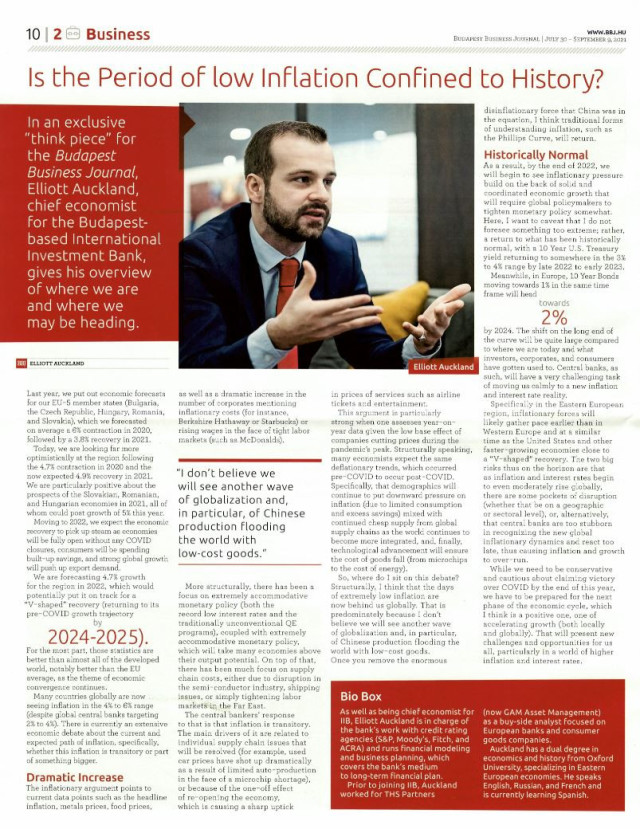IIB Chief Economist Elliott Auckland gives his overview on where we are and where we may be heading in an exclusive "think piece" for the Budapest Business Journal
Source: Budapest Business Journal
Economic recovery 2021-22
Last year IIB put out economic forecasts for its EU-5 Member States (Bulgaria, Czech Republic, Hungary, Romania and Slovakia) which we forecasted on average a 6% contraction in 2020, followed by a 3.8% recovery in 2021. Today, we are looking far more optimistically on the region following the 4.7% contraction in 2020, and the now expected 4.2% recovery in 2021. As such, our view is that Eastern European economies will regain their 2019 levels of GDP in Q1 2022, and potentially in some cases by Q4 2021. In particular, we are especially positive on the prospects of the Slovakian, Romanian and Hungarian economies in 2021 all of whom could post growth of 5% this year. The numbers for Russia followed a similar theme, with our old forecasts of a 4% contraction in 2020 and a 3% recovery in 2021. These forecasts were slightly too pessimistic comparing to the 3% contraction in 2020 and the 3.5% recovery now expected in 2021.
Moving to 2022, we expect the economic recovery to pick-up steam as economies will be fully open without any Covid closures (unlike 2021 which so far will have a weak H1 followed by a strong H2), consumers will be spending built up savings and strong global growth will push up export demand. We are forecasting 4.7% growth for the region in 2022 which would potentially put the region on track for a V shape recovery (returning to its pre Covid growth trajectory by 2024-2025) although for the time being that remains an optimistic assumption and the region will likely have GDP about 2% lower than it would have had, if Covid had never occurred in the long-term. Those statistics are for the most part better than almost all of the developed world notably being better than the EU average as the theme of economic convergence continues.
So what has driven the improvement in economic growth (both actual and expected)?
- Firstly, Domestic Fiscal Spending has come in larger than expected which is thanks to combination of factors (such as monetary policy and a new approach on an EU wide level to fiscal spending) thus financial markets did not challenge the continued extraordinarily loose fiscal policy.
- Monetary Policy has obviously played a very important part through both conventional and unconventional tools. To ensure that the combined policy response has been the greatest in history, and ultimately, that we learnt our lessons from the 2008-2009 financial crisis as well as the European Debt crisis.
- Also, Consumers and Businesses have adapted remarkably quickly to the 2nd and 3rd waves. This also in some part reflects Government’s having a more tailored approach to lockdowns vis-à-vis Q2 2020 (although this is not uniform across all countries).
- Consumers also have shown incredible speed to restart spending once economies have re-opened reflecting that fears of economic scarring or weak consumer confidence are not fully justified.
- Critically, the region has a very strong industrial and manufacturing economy, which has helped in two ways: firstly Covid is more or less a service sector recession (tourism, restaurants, sport and entertainment etc.) as such the demand shock has not been as large in the region as in the service heavy economies such as UK, France, Spain. Secondly, as a related point, global stimulus notably from the US and China has been focused heavily in areas which benefit the industrial and manufacturing sectors. In particular, the enormous US Fiscal Stimulus currently underway will have significant spill over effects into the entire global economy and is one of the main drivers of better than expected growth projections in 2021.
- The current economic debate on inflation is something along the lines of: Look how much money has been printed, look at the recovery in commodity prices, the US output gap is way smaller than the current US Fiscal Stimulus, there is so much pent up demand in the system
- To which the main reply is; Yes a lot of money has been printed, but how do you explain Japan – they have continually printed and not been able to generate inflation. We live in an increasingly service and even digital based economy where-by commodity prices are not so important, the US is still not fully open and this stimulus package will allow it to complete a V shape recovery, rather than causing it to over-heat. On pent up demand, the main argument is that this money has gone to the rich and the old who only save and don’t spend. Those two mega economic trends are only going to get stronger: inequality and ageing, and both of them are deflationary.
- To which the reply is, demographics may not be deflationary rather inflationary for a whole host of reasons (reduced labour supply + more labour supply diverted from economically value added industries to more “maintenance” industries such as caring for the old). Inequality will now go in reverse with higher taxation to pay for global debt burden and the new social contract post covid (which may lead to wage pressure). As for Japan, Japan only didn’t have inflation in the past 20 years because of China’s incredible growth which was backed by cheap manufacturing and that was huge deflationary force. China though going forward is no longer disinflationary but inflationary.
- And the debate goes on, and the economics profession, as are investors are highly divided on this.
- So where do I sit on this debate? And why do I consider it relevant to Eastern Europe? Firstly, it’s relevant because what goes on in the US, the leading European Economies and in China has an enormous impact on setting exchange rates, interest rates and inflation rates in smaller countries and regions as a whole. So, we can build an argument for inflationary pressure in the CEE, which by the way, I think has a lot of fuel to it given an stronger expected recovery going forward, relatively low unemployment, large fiscal spending etc. But, if the globe will remain in a deflationary environment, it is quite hard to see Eastern Europe countries bucking that trend in a major way – particularly given how integrated the region is not only into Supply chains of countries like Germany, but also how integrated the region is from an FX and Interest Rate perspective with the Euro-zone and in particular with ECB monetary policy.
- So, I do think that the days of extremely low inflation are now behind us on a global level. Predominately, because I don’t think that we will see another wave of globalization and in particular, of Chinese production flooding the world with low cost goods. That doesn’t mean to say I believe we are going into a world of deglobalization, rather, we may flutter around current levels, as such that the prior positive force on bringing down inflation will become more neutral. As for China, I think they have been incredibly successful at taking a $1000 GDP per capita economy to a $10,000 GDP per capita economy, but to move to higher levels of per capita, requires a more fine tuned approach to economic management which may prove difficult to adapt to, but even if they succeed in doing that, such a development will undoubtedly be inflationary as China moves from being a global producer or exporter to a global consumer or importer. In other words, I do believe on the large part that the economies such as Vietnam and Bangladesh are too small to impact global dynamics to ensure continued disinflationary forces as we look for a new source of cheap goods, so we can no longer rely on the Far-East to keep global supply chain costs low.
- Once you remove the enormous disinflationary force that China was in the equation, I think traditional forms of understanding inflation such as the Phillips Curve will return. As a result, by the end of 2022 on the back of strong and coordinated economic growth we will begin to see inflationary pressure build as such that will require global policy makers to tighten monetary policy somewhat. Here, I want to caveat that I do not foresee something too extreme, rather a return to what has been historically normal; with a 10 Year US Treasury yield returning to somewhere in the 3% to 4% range by late 2022 early 2023. Meanwhile in Europe, 10 Year Bunds moving towards 1% in the same time period, towards 2% by 2024. Of course on the shorter end of the curve, rates will remain tied down to Central Bank base rates.
- The shift on the long-end of the curve will be quite a large shift compared to where we are today and to what investors, corporates and consumers have got used to. Central Banks as such will have a very challenging task of moving us calmly to a new inflation and interest rate reality as compared to the one we have got used to over the past decade.
- Specifically in the Eastern European region, inflationary forces will likely gather pace earlier than in Europe and at a similar time as with the United States and other faster growth economies, which are close to a “V shaped” recovery. Some countries such as Russia have already started raising rates on the back of stronger inflation and relatively strong domestic demand. The EU Eastern European countries though will likely have more time to exit accommodative policy given the ties to the Euro-zone and the ECB which is likely to keep negative rates until 2023. That being said, lower debt levels in the CEE region than the rest of Europe will make the economies less sensitive to higher interest rates than in the Euro-zone and thus making higher interest rates more likely and more sustainable.
- The two big risks thus on the horizon are that as inflation and interest rates begin to even moderately rise globally there are some pockets of disruption (whether that be on a geographic or sectoral level) or alternatively, that Central Banks are too stubborn in recognising the new global inflationary dynamics and re-act too late, thus causing inflation and growth to over-run. Of these two risks, I see the later being more relevant as policy stance may remain too accommodative for too long as the output gap will close quickly over the coming 12-24 months. Meanwhile, in other parts of the world local economies may still be suffering from output gaps and a slow recovery while the US is forced to started a monetary tightening cycle and thus leading to capital outflows from Emerging Markets – such a situation could occur if the global economic recovery is not synchronized (which given the extremely slow vaccine roll out in some Emerging Markets may be the case) – luckily for this region that will not be the case.
- As such, in summary, while we need to be conservative and cautious about claiming victory over Covid by the end of this year. We have to be prepared for the next phase of the economic cycle, which I think is a positive one, one of accelerating growth (both locally and globally). That will present new challenges and opportunities and we need to be prepared for a world of higher inflation and interest rates.
Of course, against this fairly rosy outlook there are some ifs and buts. The first one being what if we cannot solve Covid so quickly; namely that vaccine roll-out continues to disappoint. However, here I would mention that the recent figures are very encouraging, with a decent number of European economies now with first dose vaccinations around the 20% level – meaning we are on track to reach herd immunity in Europe in 2021, Hungary leading the way inside the EU with 35%. (Although unfortunately for tourism related economies not soon enough to save entirely summer 2021 – the southern tourism dependent European economies will likely suffer another very tough year, and may well suffer from long-term economic scarring as a result of the Covid crisis. That being said, by 2023, tourism flows should return to their 2019 levels).
Another downside risk on growth would be a slow and/or failed roll out of the EU next generation funds. Although, recent developments appear to indicate that there will be timely ratification and implementation. The willingness of the EU to further integrate fiscally is a huge positive for all of the countries in the region who stand to benefit not only directly from continued EU funds but indirectly through an implicit guarantee which allows governments to finance themselves at tight spreads without having to worry about serious speculative attacks from market players. Of course, nothing is ever truly for free, and I expect in the coming decade the list of euro denominated countries in the Eurozone and specifically from this region to grow. For most countries in the region (although perhaps not all), joining the Euro-zone would be a net positive as it would open the gateway for even cheaper and larger volumes of financing in terms of both debt and equity.
Rather, the more pressing challenge to the rosy outlook is one of inflation.


